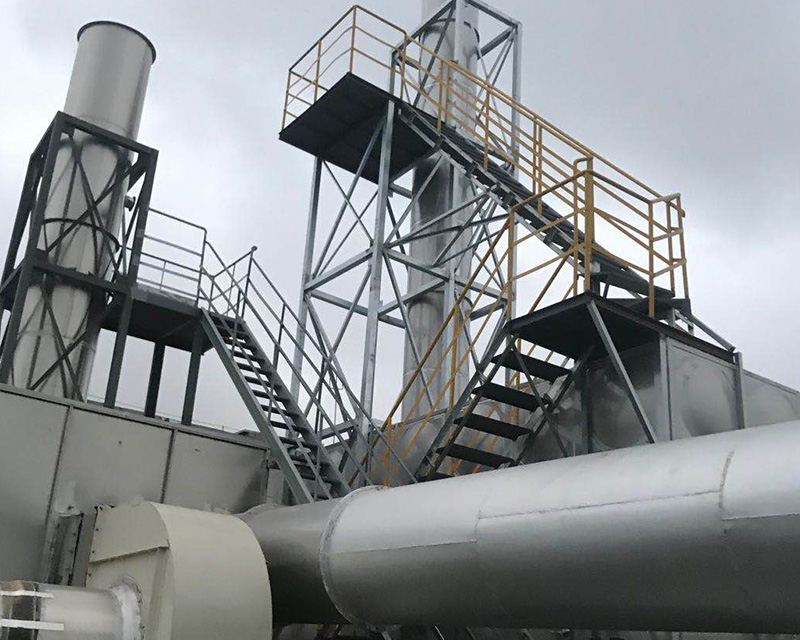1. The high-energy and high ozone ultraviolet beam is used to decompose oxygen molecules in the air to produce free oxygen, namely active oxygen. Because the positive and negative electrons carried by free oxygen are unbalanced, it needs to combine with oxygen molecules to produce ozone. UV+O2 → O -+O * (active oxygen) O+O2 → O3 (ozone). As we all know, ozone has a strong oxidizing effect on organic matter, and has an immediate effect on the removal of organic gases and other irritating odors. After the organic gas is input into the purification equipment through the exhaust equipment, the organic (odor) gas is decomposed and oxidized by high-energy ultraviolet beam and ozone, so that the organic gas substances can be degraded into low molecular compounds, water and carbon dioxide, and then discharged out of the room through the exhaust pipe.
2. When the catalyst (titanium dioxide) is exposed to ultraviolet light, it generates highly active superoxide anion free radicals and hydrogen oxygen free radicals to attack the organic matter and degrade the organic matter. Titanium dioxide is a kind of insoluble material. While thoroughly decomposing organic pollutants and sterilizing, it does not decompose and dissolve itself. It has a lasting photocatalytic effect and has a lasting effect of sterilizing and degrading pollutants.
B uv photolysis equipment, V photooxygen Microwave deodorization equipment Photo oxygen catalytic waste gas purifier, also known as photo oxygen waste gas purifier, is equipped with UV ultraviolet light tubes to remove odor. It has a strong adaptability, low operating cost, and no need for pretreatment. Application range: oil plants, rubber plants, chemical plants, pharmaceutical plants, sewage treatment plants, garbage transfer stations and other odor gas deodorization and purification treatment.
1. The deodorization and purification equipment can be used alone or flexibly matched with low-temperature plasma waste gas treatment
2. Equipment, lampblack purification device and other purification devices are used together.
3. The deodorization rate can be configured in 85% and 95% specifications as required.
4. The equipment has complete specifications and models from 4000 air volume to 80000 air volume, and other models can be customized.
1. Whether the malodorous substances can be cracked depends on whether their chemical bond energy is lower than the energy of the UV photons provided.
2. The time of cracking reaction is very short (<0.01 s), and the time of oxidation reaction is 2-3 s.
3. If the total power of the UV photons provided is insufficient or the oxygen content is insufficient, some intermediate by-products will be generated due to incomplete cracking or oxidation, thus affecting the purification efficiency. It is obvious for high concentration macromolecular organic odor substances
4. The long-term stability of UV photolysis purification requires that the reaction temperature is less than 70 ℃, the dust volume is less than 100mg/m3, and the relative humidity is less than 99%.
5. When the conditions are met, the purification efficiency of UV photolysis purification can reach 99.9% or more. For some organic compounds, the partial chemical bond energy is higher than the UV photon energy provided, for example, the "C=O" bond energy of formaldehyde is 728 kj/mol. At present, the energy of UV photons provided by us is 704kj/mol (742kj/mol and 800kj/mol are under development). Under the irradiation of 170 nm UV light, formaldehyde will decompose to generate free [C=O] * and H *. A part of [C=O] * reacts with 03 to generate CO2, and a part of [C=O] * loses energy after collision with inert substances such as N2 to generate CO. When the amount of ozone is sufficient, part of CO can be oxidized to CO2. If the UV wavelength provided is 160nm (742kj/mol), the reaction process is relatively simpler: formaldehyde will be directly cracked into free C *, H *, and directly oxidized to CO2 and H2O by O3. It can be seen from the above that the photodegradation reaction of the same substance can be different for UV rays of different wavebands. The shorter the wavelength of UV rays is, that is, the higher the UV photon energy is, the easier the photodegradation reaction of the substance will be. On the contrary, it will be more difficult, or even have no effect.

